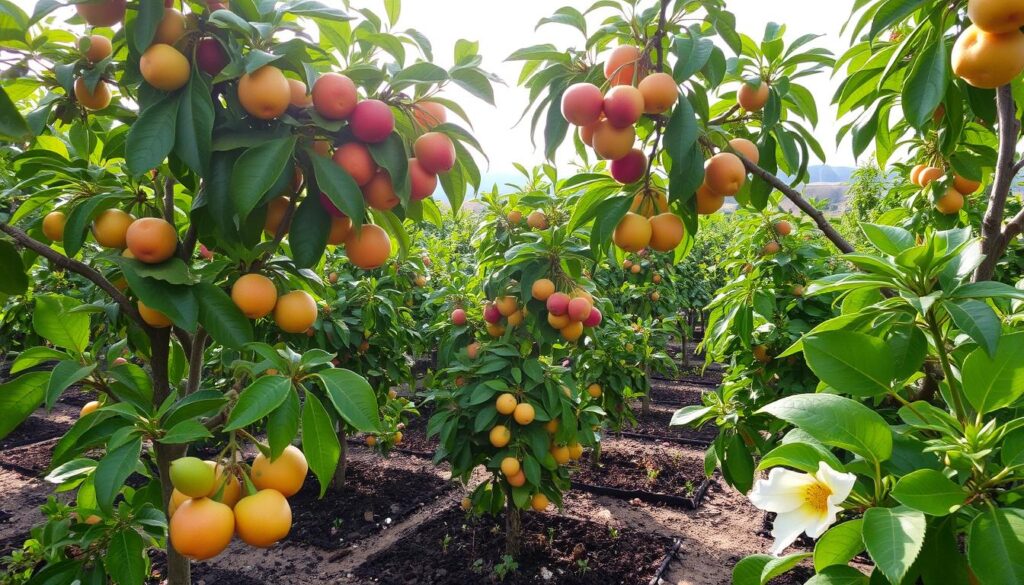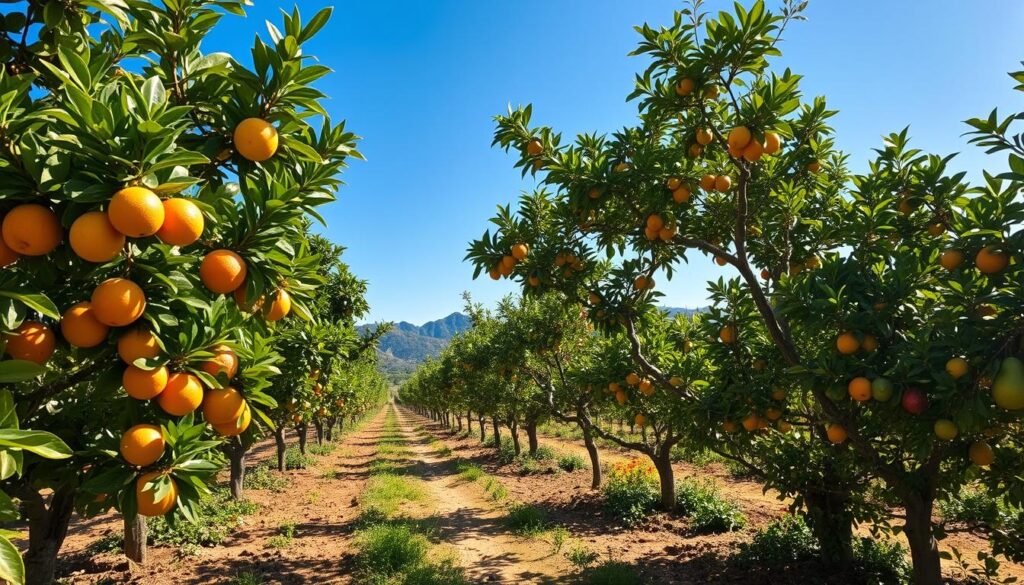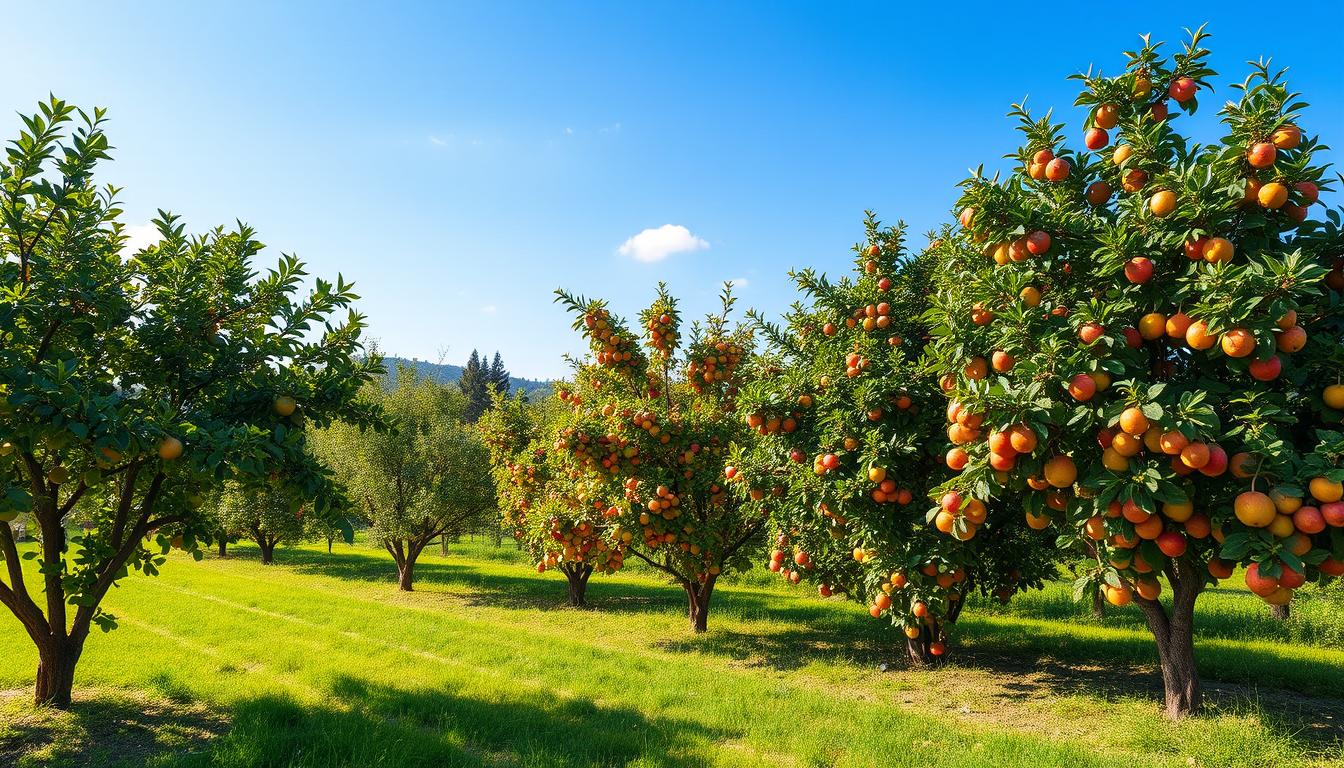Starting a garden is exciting, but picking the right fruit trees is key. I start by finding out which fruits I like and can grow in my area. Knowing your hardiness zone is important. It shows the average low temperatures in your region.
Choosing the wrong trees can lead to disappointment. Websites like Garden Beginner offer great advice. They help you understand your growing conditions and plan for a bountiful harvest.
Key Takeaways
- Understanding your hardiness zone is crucial for selecting fruit trees that will thrive in your climate.
- Research is essential when considering chill hours needed for different fruit varieties.
- Choosing climate-appropriate fruit trees can maximize your harvest and reduce maintenance efforts.
- Local resources and recommendations from fellow gardeners can aid in making informed selections.
- Assessing available space and soil conditions plays a vital role in decision-making.
Understanding Hardiness Zones
The United States Department of Agriculture (USDA) divides areas into hardiness zones based on the coldest temperature each year. These zones go from 1a, the coldest, to 13b, the warmest. Each zone is five degrees apart. Knowing your hardiness zone is key to picking climate-specific fruit tree varieties that will do well in your area.
Lower zone numbers mean colder winters. Since the USDA last updated their zones in 2012, microclimates can affect temperatures. This means some areas might have different conditions than their zone suggests. For example, different apple tree varieties can handle different levels of winter cold.
In warmer climates, winters are shorter and milder. Fruit trees have specific dormancy cycles for these conditions. Some trees, like apple and pear, need a certain number of chill hours to produce fruit. Brands like Cummins Nursery offer trees for zones 5, 6, and 7, reminding customers to check their zone before buying.
Choosing trees that match your climate ensures they will grow well. Trees for colder zones won’t do well in warm places like Florida. Cold-hardy trees are essential in harsh winters, while tropical trees struggle in cold areas.
Knowing your zone’s growing conditions is key for planting fruit trees. The best time to plant varies by region but is usually during cooler weather. This helps dormant trees adjust and grow healthily as they settle in.
| Hardiness Zone | Temperature Range (°F) | Fruit Trees Suitable |
|---|---|---|
| 1a | -60 to -55 | Cold-hardy apple, Cherry |
| 5 | -20 to -10 | Red Maple, Blueberry, Pear |
| 7 | 0 to 10 | Pear, Plum, Peach |
| 10 | 30 to 40 | Citrus, Fig, Pomegranate |
| 13b | 60 to 70 | Pineapple, Coconut, Mango |
How to Choose the Right Fruit Trees for Your Climate
Choosing fruit trees for your area can be both rewarding and challenging. To make good choices, it’s important to understand hardiness zones and chill hours. These factors help pick the right fruit trees for your climate.
Defining Hardiness Zones
Hardiness zones tell us which plants can survive in certain climates. These zones are based on the average winter temperatures. Knowing your hardiness zone helps pick fruit trees that will grow well.
For example, different zones have different temperatures. Picking trees that match your zone ensures they grow and produce fruit better.
Importance of Chill Hours
Chill hours are key for some fruit trees, especially deciduous ones. These hours are when the temperature is below 45°F during their dormant season. For instance, in the Valley of the Sun, there are about 350 chill hours.
Knowing how many chill hours a tree needs helps make better choices. This is especially true for stone and pome fruits. Trees like Feijoa need at least 50 chill hours per year.
Local nurseries and gardening groups offer great advice on choosing fruit trees. They know what works best in your area. Their insights help make sure you pick trees that will give you a good harvest.
For more on these topics, check out our information on affiliate programs. It shows our dedication to giving you reliable gardening advice.
Benefits of Climate-Appropriate Fruit Trees
Choosing fruit trees that fit your climate has many benefits. It means you get a lot of fruit and need to do less work. This makes gardening easy and fun over time.
Maximizing Your Harvest
By picking fruit trees that match your area’s climate, you can get more fruit. These trees grow better because they’re in the right place. Knowing how much cold they need helps pick the best ones.
For example, apple, pear, and peach trees need different amounts of cold. Picking ones that need less cold means more fruit for you.
Reducing Maintenance Efforts
Choosing the right trees also means less work for you. Trees that fit your climate are stronger and less likely to get sick or attract pests. This saves you time and effort, so you can enjoy your garden more.
Knowing how to care for different trees helps too. For instance, some trees need more pruning than others. Picking trees that fit your climate makes gardening a joy, not a chore.
How to Assess Your Growing Conditions
To grow fruit trees well, I start by checking my garden’s growing conditions. Knowing my hardiness zone is key. It tells me which fruit trees will do well in my climate. This helps them thrive and grow fruit.
After that, I look at the microclimates in my yard. These small areas have their own climate. This can affect how different trees grow.
Identifying Your Hardiness Zone
The USDA Plant Hardiness Zone Map helps me find my zone. Each zone shows the temperature range for plants to survive winter. For example, apple trees do well in zones 4-8, and citrus trees need warmer zones 9-11.
Choosing the right tree for my zone is important. I pick ‘Honeycrisp’ apples for colder areas. And for frost resistance, I choose ‘Blake’s Pride’ pears.
Analyzing Microclimates
After knowing my zone, I look at my garden’s microclimates. These small areas have different climates than the rest of the garden. Sunny spots are good for tender fruits, while shaded areas are better for hardier trees.
By watching my yard all year, I find the best spots for trees. Wind, soil, and moisture levels all play a part. Knowing these helps me plant trees in the right places.

Best Fruit Trees for Cold Climates
In cold climates, picking the right fruit trees is key for a good harvest. I choose high chill hour varieties because they handle harsh winters well. Knowing the chill hour needs helps me pick the best trees for cold areas.
Choosing High Chill Hour Varieties
High chill hour trees need 600 to 1,000 chill hours to grow well. They include apples and cherries, which do great in cold and produce lots of fruit. Doing my research helps me find these hardy trees.
Examples of Suitable Fruit Trees
Some fruit trees that do well in cold are:
| Type of Fruit | Varieties | Chill Hours Required |
|---|---|---|
| Apple | Empire, Honeycrisp, Gravenstein, Cox Orange Pippin | 600-1,000 |
| Cherry | Montmorency, Romeo, Juliet | 600-1,000 |
| Plum | Burbank, Superior, Toka | 600-1,000 |
By picking these varieties, I increase my chances of a good harvest. For more tips, I check out this guide to make smart choices in my garden.
Best Fruit Trees for Warm Climates
In warm climates, picking the right fruit trees is key to a great harvest. Many low chill fruit varieties do well in mild winters. Knowing which ones thrive is crucial for a successful garden.
Low Chill Varieties
For my garden in a warm climate, low chill fruit varieties are a must. Apple trees like Anna and Dorsett Golden need only 100 to 400 chill hours. Peaches, such as Florida Prince and Tropic Beauty, also do well with 150 to 400 chill hours.
Apricot lovers can choose Flavor Delight Aprium or Katy, which need 300 to 350 chill hours. Cherry trees, like Royal Crimson and Stella, also adapt well, needing 150 to 400 chill hours.
Fruits Thriving in Warm-Winter Areas
Besides low chill options, fruits that love warm winters are great too. Fig trees like Celeste and Chicago Hardy are perfect for humid areas. Persimmons, including Fuyu and Hachiya, and pomegranates, like Wonderful and Sweet, add something special.
Pear trees, such as Kieffer and Hosui, also perform well, needing 150 to 450 chill hours. Choosing the right ones ensures a fruitful garden.
To keep these trees happy, they need sunlight, well-drained soil, and regular care. Knowing this helps grow the best fruit trees for warm climates. For more tips, check out this guide for more insights.

| Fruit Type | Varieties | Chill Hours |
|---|---|---|
| Apple | Anna, Dorsett Golden | 100-400 |
| Peach | Florida Prince, Tropic Beauty | 150-400 |
| Apricot | Flavor Delight Aprium, Katy | 300-350 |
| Cherry | Royal Crimson, Stella | 150-400 |
| Fig | Celeste, Chicago Hardy | N/A |
| Persimmon | Fuyu, Hachiya | N/A |
| Pear | Kieffer, Hosui | 150-450 |
| Pomegranate | Wonderful, Sweet | N/A |
Considering Your Available Space
When thinking about fruit trees, it’s key to know your options. Standard and compact trees change your gardening game. Container gardening is a great way to grow trees in small spaces like patios or balconies. It lets you manage your garden, no matter the backyard size.
Container Gardening Options
Container gardening lets you pick from many plants, even with little space. You can use pots or raised beds for dwarf fruit trees. This way, you can enjoy fresh fruits without using up too much area. It’s perfect for different spaces and setups, and you can place containers for the best sunlight.
Dwarf and Semi-Dwarf Varieties
Dwarf fruit trees are great because they’re small but still produce tasty fruit. They’re perfect for tight spaces in cities or suburbs. Semi-dwarf trees are a good middle ground, offering easy access for picking while needing less space than regular trees. They help you make the most of your space.
| Type of Tree | Size | Container Compatibility | Fruit Yield |
|---|---|---|---|
| Dwarf Apple | 4-8 feet | Highly compatible | Moderate |
| Dwarf Peach | 4-6 feet | Highly compatible | High |
| Semi-Dwarf Pear | 8-12 feet | Moderately compatible | High |
| Dwarf Citrus (Meyer Lemon) | 3-5 feet | Highly compatible | Moderate |
Picking the Right Fruit Trees for Your Region
To grow fruit trees well in my area, I need to research local varieties. Each region’s climate affects which trees will do best. It’s key to look into researching local fruit varieties.
By checking local gardening forums, agricultural extensions, or nursery resources, I can find out which fruit trees are best for my area.
Researching Local Varieties
Connecting with local gardeners is a smart move. They share their experiences with different fruit trees. This helps me pick the right ones for my region.
For example, in Oregon, Gala and Granny Smith apples and Bartlett pears are top choices. Knowing how many chill hours they need, like 400-1000 for apples, helps me make better choices.
Recommendations from Local Gardeners
Visiting local nurseries is also helpful. Gardeners there share their successes with unusual varieties. They might talk about self-fruitful options like Fuyu persimmon, needing only 200 chill hours.
Using their advice in my planting plan can save me from mistakes. For more tailored advice, I can get expert gardening advice that fits my climate.



Leave a Reply